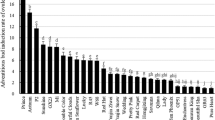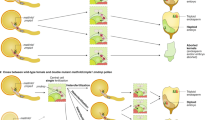Abstract
Specialized plant tissue culture methods have enabled the production of completely homozygous breeding lines from gametic cells in a shortened time frame compared to conventional plant breeding. Plants from gametic cells of an F1 hybrid represent a gametic array each having a different genetic contribution from the parents. Lines exhibiting the desired characteristics are chosen for large-scale field trials as a prelude to commercialization. Although the number of new plant varieties developed via this method has been limited, refinement of tissue culture techniques has extended the range of crop species from which haploid plants have been produced as well as the efficiency resulting in large-scale haploid plant production. Several varieties developed via this method are grown on considerable acreage while others are being tested as candidates to replace varieties developed by conventional methods.
This is a preview of subscription content, access via your institution
Access options
Subscribe to this journal
Receive 12 print issues and online access
$209.00 per year
only $17.42 per issue
Buy this article
- Purchase on Springer Link
- Instant access to full article PDF
Prices may be subject to local taxes which are calculated during checkout
Similar content being viewed by others
References
Kasha, K.J. and Kao, K.N. 1970. High frequency haploid production in barley (Hordeum vulgare L.). Nature 225:874–876.
Keller, W.A., Arnison, P.G. and Cardy, B.J. 1987. Haploids from gametophytic cells—recent developments and future prospects, p. 223–241. In: Plant Tissue and Cell Culture, Green, C. E., Somers, D. A., Hackett, W. P., Biesboer, D. D. (Eds.), A. R. Liss, New York.
Maheshwari, S.C., Rashid, A. and Rayagi, A.K. 1982. Haploids from pollen grains—retrospect and prospect. Am. J. Bot. 69:865–879.
Niizeki, H. and Oono, K. 1971. Rice plants obtained by anther culture. Colloq. Int. C.N.R.S. 193:215–257.
Guha-Mukherjee, S. 1973. Genotypic differences in the in vitro formation of embryoids from rice pollen. J. Exp. Bot. 24:139–144.
Wang, C.C., Chu, C.C., Sun, C.S., and Wu, S.H. 1973. The androgenesis in wheat (Tnlicum aestivum) anthers cultured in vitro. Sci. Sin. 21:218–222.
Clapham, D. 1973. Haploid Hordeum plants from anthers in vitro. Z. Pflanzenzucht. 69:142–155.
Wenzel, G. and Thomas, E. 1974. Observations on the growing in culture of anthers of Secale cereale. Z. Pflanzenzucht. 72:89–92.
Thomas, E. and Wenzel, G. 1975. Embryogenesis from microspores of Brassica napus. Z. Pflanzenzucht. 74:77–81.
Keller, W.A. and Armstrong, K.C. 1979. Stimulation of embryogene-sis and haploid production in Brassica campestris anther cultures by elevated temperature treatments. Theor. Appl. Genet. 55:65–67.
Kasperbauer, M.J. and Collins, G.B. 1972. Reconstitution of diploids from leaf tissues of anther-derived haploids in tobacco. Crop Sci. 12:98–101.
Sopory, S.K. and Rogan, P.G. 1976. Induction of pollen divisions and embryoid formation in anther cultures of some dihaploid clones of Solanum tuberosum. Z. Pflanzenphysiol. 80:77–80.
Morrison, R.A., Koning, R.E., and Evans, D.A. 1986. Anther culture of an interspecific hybrid of Capsicum. J. Plant Physiol. 126:1–9.
Wu, J.L., Zhong, Q.L., Nong, F.H., and Chang, T.M. 1980. Embryogenesis in corn culture. Acta Photo. 6(2):221–224.
Uhrig, H. 1985. Genetic selection and liquid medium conditions improve the yield of androgenetic plants from diploid potatoes. Theor. Appl. Genet. 71:455–460.
Wu, J. 1986. Breeding corn by anther culture, p. 149–164. In: Haploids of Higher Plants In Vitro. Hu, H. and Yang, H. (Eds.). Springer-Verlag, Berlin.
Gupta, S.C. and Babbar, S.B. 1980. Enhancement of plantlet formation in anther cultures of Datura metel L. by prechilling buds. Z. Pflanzephysiol. 96:465–470.
Lazar, M.D., Schaeffer, G.W., and Baenziger, P.S. 1985. The physical environment in relation to high frequency callus and plantlet development in anther cultures of wheat (Triticum aestivum L.) cv. Chris. J. Plant Physiol. 121:103–109.
Keller, W.A., Armstrong, K.C., and de la Roche, A.I. 1982. The production and utilization of microspore-derived haploids in Brassica crops, p. 169–183. In: Plant Cell Culture in Crop Improvement, Giles, K. L. and Sen, S. K. (Eds.). Plenum, New York.
Heberle-Bors, E. 1982. In vitro pollen embryogenesis in Nicotiana labacum L. and its relation to pollen sterility, sex balance, and floral induction of the pollen donor plants. Planta 156:396–401.
Kohler, F. and Wenzel, G. 1985. Regeneration of isolated barley microspores in conditioned media and trials to characterize the responsible factor. J. Plant Physiol. 121:181–191.
Dunwell, J.M. and Thurling, N. 1985. Role of sucrose in microspore embryo production in Brassica napus spp. oleifera. J. Exp. Bot. 36:1478–1491.
Johansson, L., Andersson, B., and Eriksson, T. 1982. Improvement of anther culture technique:Activated charcoal bound in agar medium in combination with liquid medium and elevated CO2 concentration. Physiol. Plant 54:24–30.
Heberle-Bors, E. 1985. In vitro haploid formation from pollen:a critical review. Theor. Appl. Genet. 71:361–374.
Martensson, B.K. and Widell, S. 1987. Separation of precultured pollen from Nicotitana labacum by aqueous polymer two-phase partition. Plant Cell, Tissue, and Organ Culture 8:27–35.
Evans, D.A. and Sharp, W.R. 1986. Somaclonal and gametoclonal variation, p. 97–132. In: Handbook of Plant Cell Culture, Vol. 4. Evans, D. A., Sharp, W. R., and Ammirato, P. V. (Eds.). Macmillan, New York.
Morrison, R.A. and Evans, D.A. 1987. Gametoclonal variation, p. 359–391. In: Plant Breeding Reviews, Volume 5. Janick, J. (Ed.). AVI Press, Westport, Conn.
Sanders, M.E. and Franzke, C.J. 1976. Effect of temperature on origin of colchicine-induced complex mutants in sorghum. J. Hered. 67:19–29.
Simantel, G.M. and Ross, J.G. 1964. Colchicine-induced somatic chromosome reduction in sorghum. IV. An induced haploid mutant. J. Hered. 55:3–6.
Franzke, C.J. and Rose, J.G. 1952. Colchicine induced variants in sorghum. J. Hered. 43:107–115.
Hoffmann, F., Thomas, E., and Wenzel, G. 1982. Anther culture as a breeding tool in rape. II. Progeny analyses of androgenetic lines and induced mutants from haploid cultures. Theor. Appl. Genet. 61:225–232.
Burk, L.G. and Matzinger, D.F. 1976. Variation among anther-derived doubled haploids from an inbred line of tobacco. J. Hered. 67:381–394.
Franzone, P.M., Fischbeck, G., Foroughi-Wehr, B., and Friedt, W. 1984. Analysis of origin in androgenetic plants of Hordeum vulgare by the use of balanced lethal systems. Z. Pflanzenzucht. 93:320–330.
Chen, Y. 1986. Anther and pollen culture of rice, p. 3–25. In: Haploids of Higher Plants In Vitro. Hu, H., Yang, H. (Eds.). Springer-Verlag, Berlin.
Orton, T.J. and Bowers, M.A. 1985. Segregation of genetic markers among plants regenerated from cultured anthers of broccoli (Brassica oteracea var. italica). Theor. Appl. Genet. 69:637–643.
Cardy, B.J. 1986. Production of anther-derived doubled haploids for breeding oilseed rape (Brassica napus L.). Ph.D. Thesis, University of Guelph, Guelph, Ont. Canada.
Powell, W., Borrmo, E.M., Allison, M.J., Griffiths, D.W., Asher, M.J.C., Dunwell, J.M. 1986. Genetical analysis of microspore-derived plants of barley (Hordeum vulgare). Theor. Appl. Genet. 72:619–626.
Arcia, M.A., Wernsman, E.A., and Burk, L.G. 1978. Performance of anther-derived dihaploids and then conventionally inbred parents as lines in F1 hybrids and in F1 generations. Crop Sci. 18:413–418.
Day, A. and Ellis, T.H.N. 1984. Chloroplast DNA deletions associated with wheat plants regenerated from pollen: possible basis for maternal inheritance of chloroplasts. Cell 39:359–368.
Chen, C.M., Chen, C.C., and Lin, M.H. 1982. Genetic analysis of anther-derived plants of rice. J. Hered. 73:49–52.
Chen, C.C., Chiu, W.L., Yu, L.J., Ren, S.S., Yu, W.J., and Lin, M.H. 1983. Genetic analysis of anther-derived plants of rice: Independent assortment of unlinked genes. Can. J. Genet. Cytol. 25:324–328.
Collins, G.B., Legg, P.D., Kaspcrbauer, M.J. 1974. Use of anther-derived haploids in Nicotiana. I. Isolation of breeding lines differing in total alkaloid content. Crop Sci. 14:77–80.
Powell, W., Caligari, P.D.S., and Dunwell, J.M. 1986. Field performance of lines derived from haploid and diploid tissues of Hordeum vulgare. Theor. Appl. Genet. 72:458–465.
Oono, K. 1981. In vitro methods applied to rice, p. 273–298. In: Plant Tissue Culture. Thorpe, T. A. (Ed.). Academic Press, New York.
Burk, L.G., Chaplin, J.F., Gooding, G.V., and Powell, N.T. 1979. Quantity production of anther-derived haploids from a multiple disease resistant tobacco hybrid. I. Frequency of plants with resistance or susceptibility to tobacco mosaic virus (TMV). potato virus (PVY), and root knot (RK). Euphytica 28:201–208.
Wang, L. and Hu, H. 1985. The chromosome constitution of plants derived from pollen of hexaploid triticale x common wheat F1 hybrids. Theor. Appl. Genet 70:92–96.
Griffing, B. 1975. Efficiency changes due to use of doubled-haploids in recurrent selection methods. Theor. Appl. Genet. 46:367–386.
Fehr, W.R. 1987. Principles of cultivar development. Vol. 1, Theory and Technique, p. 319–327, Macmillan, New York.
Charmet, G. and Branlard, G. 1985. A comparison of androgenetic doubled haploid and single seed descent lines in Triticale. Theor. Appl. Genet. 71:193–200.
Winzeler, H., Schmid, J., and Fried, P.M. 1987. Field performance of androgenetic doubled-haploid spring wheat lines in comparison with lines selected by the pedigree system. Plant Breeding 99:41–48.
Schnell, R.J., Wernsman, F.A., and Burk, L.G. 1980. Efficiency of single seed descent vs. anther-derived dihaploid breeding methods. Crop Sci. 29:619–622.
Powell, W., Caligari, P.D.S., and Thomas, W.T.B. 1986. Comparison of spring barley lines produced by single seed descent, pedigree inbreeding, and doubled haploidy. Plant Breeding 97:138–146.
Nakamura, A., Itagaki, R., and Kobayashi, K. 1973. Studies on breeding tobacco by haploidy utilizing anther culture. IV. Comparison of the characteristics of H2 and Coker 139 and their doubled-haploid lines. Bull. Iwata Tobacco Exp. Sta. 6:29–34.
Nakamura, A., Kadotani, N., and Itagaki, R. 1974. Improvement of flue-cured tobacco variety MC1610 by means of haploid breeding method and some problems of this method, p. 277–278. In: Haploids in Higher Plants. Kasha, K.J. (Ed.). Univ. Guelph, Guelph. Ontario, Canada.
Hoffmann, F. and Wenzel, G. 1981. Self-compatibility in microspore-derived doubled-haploid rye lines and single grain selection for alkylrescorcinol content. Theor. Appl. Genet. 60:129–133.
Friedt, W., Lind, V., Walther, H., Foroughi-Wehr, B., Suchner, S., and Wcnzel, G. 1983. The value of inbred lines derived from Secale cereale X S. vamlovii via classical inbreeding and androgenetic haploids. Z. Pflanzenzucht 91:89–103.
Friedt, W. and Foroughi-Wehr, B. 1983. Field performance of androgenetic doubled-haploid spring barley from F1 hvbrids. Z. Pflanzenzucht. 90:177–184.
Friedt, W. and Foroughi-Wehr, B. 1984. Rapid production of recombinant barley yellow mosaic virus resistant Hordeum vulgare lines by anther culture. Theor. Appl. Genet. 67:377–382.
Hu, H. and Zeng, J.Z. 1984. Development of new varieties via anther culture, p. 65–90. In: Handbook of Plant Oil Culture, Volume 3. Ammirato, P. V., Evans, D. A., Sharp, W. R., and Yamada, Y. (Eds.). Macmillan, New York.
Chen, Z.H., Quian, C.K., Qin, M., Xu, X.E., Xiao, Y.L., Lin, M.Y., Deng, Z.T., Wu, S.I., Huan, N.S. 1980. Recent advances in anther culture of rubber tree and sugar cane. Ann. Rpt. Inst. Genet. Acad. Sin. p. 105.
Morrison, R.A. and Evans, D.A. Unpublished results.
Evans, D.A. 1983. Agricultural applications of protoplast fusion. Bio Technology 1:253–261.
Morrison, R.A., Evans, D.A., and Koning, R.E. 1985. Anther culture of a Nicotiana somatic hybrid. Am. J. Bot. 72:877 (abst.).
Evans, D.A., Bravo, J.E., Kut, S.A., and Flick, C.E. 1983. Genetic behavior of somatic hybrids in the genus Nicotiana: N. otophora + N. tabacum and N. sylvestris + N. tabacum. Theor. Appl. Genet. 65:93–101.
Author information
Authors and Affiliations
Rights and permissions
About this article
Cite this article
Morrison, R., Evans, D. Haploid Plants from Tissue Culture: New Plant Varieties in a Shortened Time Frame. Nat Biotechnol 6, 684–690 (1988). https://doi.org/10.1038/nbt0688-684
Issue Date:
DOI: https://doi.org/10.1038/nbt0688-684
This article is cited by
-
Precise evaluation of tissue culture-induced variation during optimisation of in vitro regeneration regime in barley
Plant Molecular Biology (2020)



